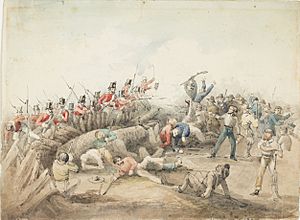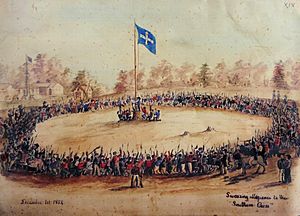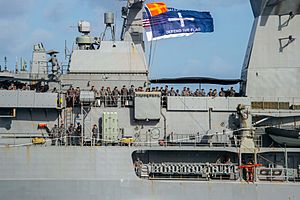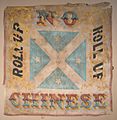Eureka Flag facts for kids
The Eureka Flag is a famous flag from Australia's history. It was flown during a big event called the Eureka Stockade on December 3, 1854. This happened in a place called Ballarat in Victoria. Before the battle, over 10,000 people gathered at Bakery Hill on November 29, 1854. They promised to support the flag as a sign of standing up for their rights.
Sadly, 22 miners were killed at the Eureka Stockade. Seven police officers and soldiers also died. About 120 miners were arrested, and many others were badly hurt.
The flag is a deep blue color, like the night sky. It measures about 260 centimeters by 400 centimeters. The white cross on it is made of cotton. The five white stars are made from a fine cotton fabric. The star in the middle is a little bigger than the others.
The Eureka Flag is very important in Victoria. It is listed on the Victorian Heritage Register. In 2006, the National Trust of Australia called it a Victorian icon. The Art Gallery of Ballarat takes care of the flag. You can see it on display at the Eureka Centre Ballarat.
Some reports from the time also mention a Union Jack flag. This flag was supposedly flown during the battle and captured along with the Eureka Flag.
Contents
History of the Eureka Flag
In 1851, Victoria became its own colony within the British Empire. Before this, it was part of New South Wales. At this time, a new government was being set up.
People were offered money to find gold near Melbourne. In August 1851, news spread that Thomas Hiscock had found lots of gold near Buninyong. Soon, many people rushed to Victoria to find their fortune. The colony's population grew from 77,000 in 1851 to nearly 200,000 by 1853.
Many different kinds of people came to the goldfields. The local government struggled to keep up. There were not enough police officers. Also, many workers left their jobs to search for gold. This caused a shortage of workers.
The government decided to charge miners a tax. This tax was based on how long they stayed, not on how much gold they found. Many miners felt this was unfair. Police would often check for licenses, which miners called "digger hunts." These checks could be very rough. Police sometimes arrested miners for not carrying their licenses. Miners were often chained to trees overnight, even in wet conditions.
Leading Up to the Rebellion
Miners held many public meetings to complain about the taxes and unfair treatment. In 1853, the Bendigo Petition with over 5,000 signatures was given to the governor. Miners also met with officials in Ballarat in 1854.
However, some miners wanted to use force to get their rights. This group became stronger after a miner named James Scobie was murdered. The owner of the Eureka Hotel, James Bently, was suspected but found not guilty. Many miners thought the police magistrate was unfair.
Another event that angered miners was the arrest of Johannes Gregorious. He was a disabled servant who was exempt from the license rule. But he was arrested and treated badly by police. He was fined, even though witnesses said he was innocent.
The anger grew, and on October 17, 1854, a large crowd of miners burned down the Eureka Hotel. On November 28, there was a fight. Miners looted a wagon train belonging to the 12th Regiment. This happened near the Eureka lead, where the miners later made their stand.
The next day, the Eureka Flag was seen for the first time. Miners burned their licenses at a big meeting of the Ballarat Reform League. This group was formed to represent the miners. Their main idea was that "taxation without representation is tyranny." This means people should have a say in the laws they must obey.
On November 30, more riots broke out. Miners threw things at soldiers and police. That afternoon, a military display took place on Bakery Hill. Miners formed companies and gathered around the Eureka Flag. They swore an oath to fight for their rights.
The Battle at Eureka Stockade
The miners, led by Peter Lalor, moved from Bakery Hill to the Eureka Stockade. This was a rough fort made of spikes and overturned carts. It was built between November 30 and December 2.
On Sunday, December 3, at dawn, government forces attacked the stockade. The battle was short and fierce, lasting about 15 minutes. At least 22 miners and seven soldiers and police died. The government forces captured the stockade.
Who Designed the Eureka Flag?

The first mention of a flag was in October 1854. A newspaper reported that someone suggested putting up a tall flagpole. Raising a "diggers' flag" would signal a meeting.
In 1885, John Wilson, who worked in Ballarat, said he designed the Eureka Flag. He said it was made from fabric by a tarpaulin maker. Another popular story says the flag was designed by "Captain" Henry Ross from Canada. A. W. Crowe said in 1893 that Ross ordered the flag from Darton and Walker. This company made tents and flags.
It is also believed that women helped make the Eureka Flag. A letter from 1855 said the flag was "made and wrought by English ladies." Some families say Anastasia Withers, Anne Duke, and Anastasia Hayes helped sew the flag. The stars are made of delicate material. This fits the story that they were made from women's petticoats. The blue wool fabric might have been from dresses or the blue shirts worn by miners.
Frank Cayley found two sketches in 1963 that might be the original plans for the flag. One sketch shows a flag with "blue" and "white" written on it. The other shows a bearded man carrying the flag. Some people think this man might be Henry Ross.
Professor Anne Beggs-Sunter mentioned a report in the Ballarat Times. It supposedly said two women made the flag from a drawing by a miner named Ross. But this newspaper is not complete, so the report cannot be found.
Some people think the Eureka Flag looks like the Australian Federation Flag. It is common for flags of rebellions to look similar to the flags they are fighting against. The flag also looks a bit like the modern Flag of Quebec. This flag was used by French-speaking people in Canada where Ross came from.
Father Tom Linane thought women from the St Aliphius chapel might have made the flag. This church used a blue and white flag to signal when mass was starting. Professor Geoffrey Blainey believed the white cross on the flag is an "Irish cross." He thought it was not just a picture of the Southern Cross constellation.
Norm D'Angri thinks the Eureka Flag was made quickly. He believes the stars have eight points because it was easiest to draw them that way.
The Famous Oath at Bakery Hill
Before the oath ceremony on November 30, 1854, the Eureka Flag was hoisted another time. Peter Lalor said he heard shots fired at miners. He and an armed crowd went to Barker and Hunt's store. There, the Eureka Flag "was procured and hoisted." But it was quickly taken down.
John Wilson said he got prisoners to help him get the flagpole for Bakery Hill. He said it was 60 feet long. He said his design of "five white stars on a blue ground, floated gaily in the breeze."
The Ballarat Times first mentioned the Eureka Flag on November 24, 1854. It talked about a meeting where "The Australian flag shall triumphantly wave." Other newspapers also called it the "Australian flag."
The Ballarat Times described the oath ceremony:
"The Southern Cross was hoisted, and its maiden appearance was a fascinating object to behold. There is no flag in Europe, or in the civilised world, half so beautiful... The flag is silk, blue ground with a large silver cross; no device or arms, but all exceedingly chaste and natural."
Lalor, holding a rifle, stood on a tree stump. He called for volunteers to form groups. He knelt at the flagpole, pointed to the Eureka Flag, and swore an oath. Over 10,000 people repeated after him: "We swear by the Southern Cross to stand truly by each other and fight to defend our rights and liberties."
Raffaello Carboni remembered that Henry Ross was like the "bridegroom" of the flag. He stood at the flagpole with his rifle group.
In 1931, R. S. Reed said an old tree stump on Victoria Street was the historic spot. He said Lalor addressed the rebels there. He wanted to protect the spot. Today, the site of the oath ceremony is likely a car park at 29 St Paul's Way, Bakery Hill.
What the Eureka Flag Means Today
Since 1854, the Eureka Flag has become a well-known symbol in Australian culture. It stands for democracy, fairness, and protest. Many Australians see it as a symbol of their country. It is often used by historical groups, re-enactors, and worker unions.
Recently, some groups with far-right political views have also used the flag. This includes groups like the Australia First Party. These groups use the flag to support their ideas, which can be different from what the miners originally fought for. Some see it as representing the miners' fight against unfair rules. Others use it to support ideas about limiting immigration. This has caused frustration for other groups who see the flag as a symbol of fairness for everyone.
In 2010, some people worried that the Eureka Flag could become a symbol of racism. Professor Greg Craven said that the flag used to be as popular as the official Australian flag. But it became linked to racist slogans. He said "The Southern Cross is becoming a symbol not of unity but of exclusion."
In 2013, a survey found that 10% of people were very proud of the flag. But 35% felt uncomfortable with its use.
In 2020, the City of Unley refused to fly the Eureka Flag. Councillor Jennifer Bonham said the flag was important for democracy. But she also noted that Chinese miners were treated badly on the goldfields. She said the flag "can also be a symbol of that persecution." Councillor Jane Russo said it had become a symbol of "white supremacy."
The Flag Through Time
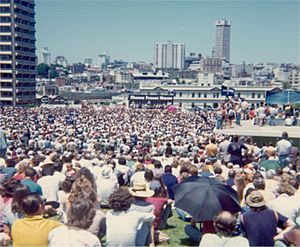
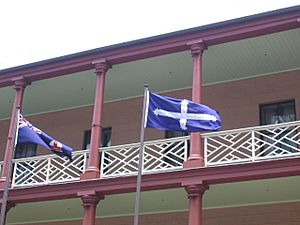
There's a story that Eureka Flags were used in a protest by seamen in 1878. In 1890, 30,000 protesters gathered in Melbourne with the flag. This was to support maritime workers. A similar flag was also seen during the 1891 Australian shearers' strike.
After World War I and the Great Depression, the Eureka Flag became popular again. It was used by groups like the New Guard and the Communist Party in the 1930s.
In 1948, 3,000 members of the Eureka Youth League marched in Melbourne with the flag. The same year, there was a fight between strikers and police in Brisbane. News reports said "Police in serious clash with strikers" and "Battle over Eureka flag." The marchers carried a Eureka Flag. Two protesters were hurt, and five were arrested in the fight over the flag.
The Eureka Flag was also used by supporters of Gough Whitlam after he was removed as prime minister. The Northcote City Council flew the flag from its Town Hall from 1979 to at least 1983.
In 1983, a supporter gave a small Eureka Flag to Diana, Princess of Wales. She did not recognize it.
In 2004, to celebrate 150 years of Eureka, the flag flew at many government buildings. This included state parliaments and the Sydney Harbour Bridge. Deputy Prime Minister John Anderson did not want it flown at Parliament House, Canberra. He felt people were making "too much of the Eureka Stockade."
Many groups use the Eureka Flag today. These include the City of Ballarat and Federation University. Worker unions like the CFMEU also use it. It is often seen on building sites. It represents fairness and standing up to authority. The flag flies permanently over the Melbourne Trades Hall and the Ballarat Trades Hall. The Prospectors and Miners Association of Victoria use it as their official flag. In 2016, the Australia First Party added it to their logo.
Sporting clubs also use the Eureka Flag. This includes the Melbourne Victory and Melbourne Rebels. Melbourne Victory fans adopted it as a club flag in 2004. It was briefly banned at A-League games, but the ban was removed after public criticism.
Images for kids


